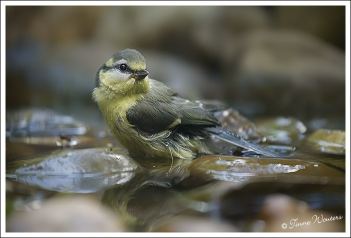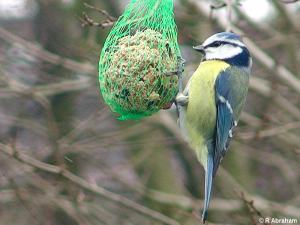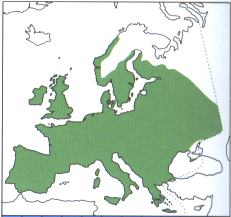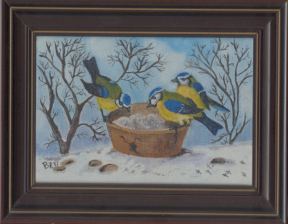Parus Caeruleus - Blue Tit
|
Drawing of
|
Description:
The Blue Tit has a body length of 12 cm, weight about 11 gram, blue feathers, wings, tail, neck, cap and black eyeline. Adults have white cheeks, but those of the juveniles are yellow. The upper side of the bird is green and the under-part is yellow. The Blue Tit sometimes has a thin black stroke on the belly.

Juvenile
Biotope:
Broodbird of places with bushes: parks, gardens, orchards and spread bushes in the open fields, just like the Great Tit, but the Blue Tit avoids conifer forests even more than the Great Tit..
Feeding:
The Blue Tit is a tireless insect hunter, eats larves, small insects, spiders, caterpillars, plant-louses, fruits, nectar and likes to eat seeds and peanuts in the winter.
 Nest:
Nest:
The Blue Tit likes to brood in a hole, for example in a natural or artificial hole (birdhouse), or in an old birdnest. The Blue Tit broods from April till the middle of June. The average brood consists of 7 till 14 eggs. Breading season: 13 till 14 days. The parents are very busy feeding the little birds. Registration equipment measured once 804 feed actions on one day (for 9 young birds at the 12th day of birth). If they are 16 till 18 days old and are able to fly, they leave the birdhouse or nest. A little couple of Blue Tits has a second brood in one year.
Geographical distribution:

De Blue Tits of West- and South Europe are in general non-migratory birds, those from
Middle- en North Europe are nomadic and sometimes migratory birds, especially after a good
brood season.
These attractive little birds are also found in Asia and north west Africa.
Voice
Blue tits have a range of calls, including seeseedu and cherrrr-errr-err, but the song is
a cheerful tsee-tsee-tsu-tsuhuhu.
Names:
| • Danish | Blåmejse |  |
| • German | Blaumeise | |
| • English | Blue Tit | |
| • French | Mésange bleue | |
| • Fries | Blaumieske | |
| • Italian | Cinciarella | |
| • Latin | Parus caeruleus | |
| • Moroccan | Ultramarinus | |
| • Zwedish | Blåmes | Painting of
|
[ Home ] [ Bird overview ]
